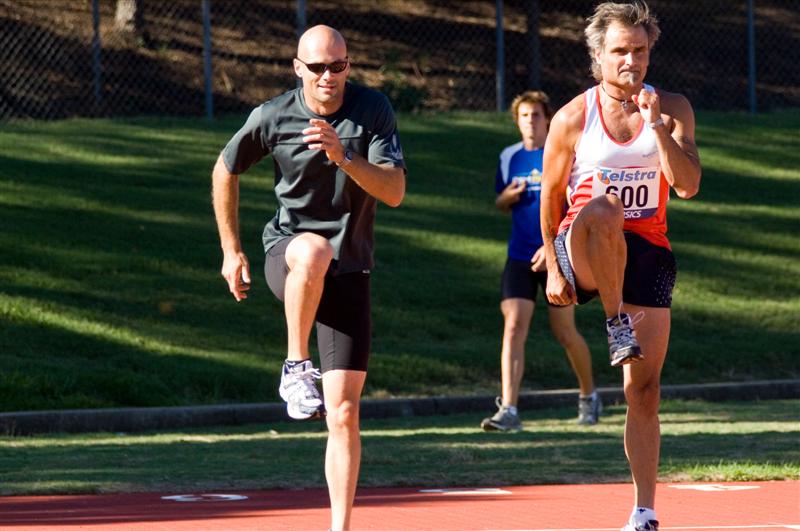Sprint Drills
Sprinting drills help establish correct neuromuscular movement patterns. Performing drills as a regular part of your training routine will enforce a correct movement pattern for your muscles.
The stride and rate will be entrenched into memory and should come naturally when racing.
In the sprint training squad I am in we perform our drills at the commencement of every single training session. Our drills take about 20% of our total training session time.
It is commonly accepted that time spent on warming up and cooling down will improve an sprinters level of performance and accelerate the recovery process needed before training or competing again. The warm up program should always include sprinter specific drills to stimulate the appropriate neuromuscular action for the range of movement and correct posture.
Drills should be performed wearing trainers and not spikes. In all the drills the coach/athlete should ensure a tall and relaxed posture with a correct range of movement of the arms.
Check for:
• Eyes focused at the end of the lane – tunnel vision
• Head in line with the spine – held high and square
• Face relaxed – soft jelly jaw – no tension – mouth relaxed
• Chin down, not out
• Shoulders held down (long neck), back (not hunched), relaxed and square in the lane at all times
• Smooth forward backward action of the arms- not across the body – drive back with elbows – brush vest with elbows – hands move from shoulder height to hips for men and from bust height to hips for the ladies
• Elbows held at 90 degrees at all times (angle between upper arm and lower arm)
• Hands relaxed – fingers loosely curled – thumb uppermost
A key to getting the most from drills is variety. Drills should not be boring. Mix up your drills every once in a while. Perform phase specific drills in the different phases of your training. Perform strength building drills during your endurance traing phase and speed drills during your pre cometition phase etc.
IMPORTANT: DO NOT RUSH OR CUT SHORT YOUR WARM UP ROUTINE !!
Bounding Drills
Bounding drills are designed to develop the explosive leg power required during starting. These types of drills are quiet stressful so they should never be used as warm-up or cool-down drills. When first performing any new drills… START LIGHT! The quickest way to injury is to perform a new drill at full intensity. Take a few session to work up to the required level of intensity.
Straight Bounding
As slow jog, bounding as high a possible using a running form and emphasizes a high-knee lift. Perform 3 sets of 10 bounds.
Outside Bounding
This drill is similar to straight bounding except the foot is placed laterally outside the normal landing position and the body is projected laterally, as well as, up and forward. Use this drill only after straight bounding has been perfected. Perform 3 sets of 10 bounds.
Inside Bounding
This drill is similar to outside bounding except that the foot is placed laterally inside the normal landing position, and the body is projected laterally, as well as, up and forward. This drill should only be used after you have perfected straight bounding.
Sprinting Drills
These drills are designed to develop the mechanics, strength, and power needed to produce maximum performance in sprinting. They are designed for use while warming up before the workout. The length and difficulty of each drill can be altered to any desired distance and intensity.
Butt Kickers
From a jog, the lower leg is allowed to swing back and to bounce off the buttocks. The upper leg should not move much. Place emphasis on allowing (not Forcing) the heel to come up to the butt.
Wall Slide
From a jog, the action is the same as for butt kickers except that the heel of the recovery leg must not travel behind the body. Imagine that there is a wall of glass running down the back, and do not allow the heel action to break the glass. This action will produce knee lift without forcing the action. As in butt kickers, when this drill is done properly, the heel will bounce off the butt.
Start And Sprint
From a stationary position, start quickly, and feel the power being applied behind your body. Ten metres out, quickly shift from running in the back of your body to sprinting in front of the body. This drill should emphasize the difference between starting technique (behind the body) and sprinting technique (in front of the body)
Quick Feet Drill
From a jog, increase your stride rate so that you take as many steps as possible in a 10-metre interval. Jog 10 metres and repeat. Emphasize quick turnover with the legs moving in front of, not behind or under, the body.
Workout Drills
These drills are designed to be a workout, or part of a workout. Typically three sets of each drill are performed. Start each drill on your toes and make an effort to remain in this position throughout the drill.
Cycling
Leaning against a wall, bar, or any other support, one leg is cycled through in a sprinting manner. Emphasize keeping the leg from extending behind the body and allow the foot to kick the buttocks during recovery and paw at the ground to complete the action. Perform 10 cycles per leg per set.
Butt Kickers
This drill is the same as butt kickers in the sprinting drills except emphasize more quickness. perform 10 kicks per set.
Down And Offs
From a high knee position, the emphasis is to decrease your foot/ground contact by hitting the ground with the ball of the foot and getting it off as fast as possible. In turn, the effort on the ground should bounce your leg up into the high knee position. Ten down and offs make one set.
Pull Throughs
Extending the leg in front of the body (like a hurdler), the leg is then brought down and through the ground contact in a power motion. Ten pull-throughs with each leg make one set.
High Knee Drill
In a quick foot ladder, have the athlete sprint through the ladder as fast as possible, touching one foot in each rung of the ladder. Emphasize high knee lift and quick ground contact. One time through the ladder is one set.
African Dance
While running forward, raise each leg to the side of your body as in hurdling, and tap each heel with your hand. Start this drill easily and gradually increase the intensity. 10 metres of this drill is one set.
Drum Major
While running forward, rotate your leg inward to the midline of the body and tap your heel at the midline. one 10-metre run is one set.
by: David Isackson (2004)


